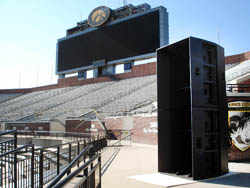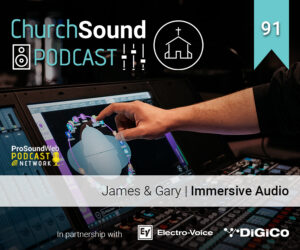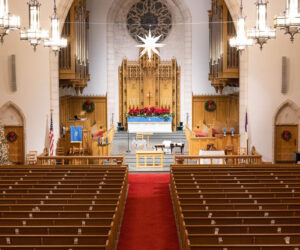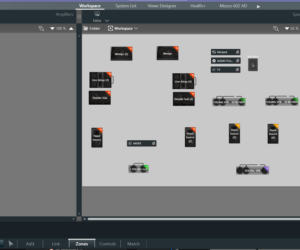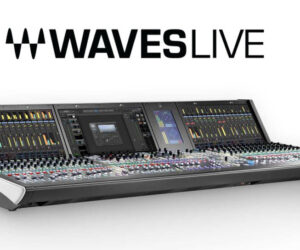Kinnick Stadium, the 70,500-seat home of the University of Iowa Hawkeyes football team in Iowa City, was recently outfitted with a new sound reinforcement system incorporating Danley Sound Labs loudspeakers, including the new large-format Caleb Horn.
“As Hawkeye management and fans traveled to other stadiums, they kept hearing sound systems that were far better than the one they had at home,” explains Marvin Smejkal, owner of Sound Concepts (Cedar Rapids, Iowa), the company under retainer with the University for audio system maintenance and operation.
“As the complaints mounted, they asked us to research the sound systems in the five best stadiums they had heard,” Smejkal continues. “Three of the five were Danley systems, which resonated with my previous experiences involving Tom Danley’s creations – I was a huge fan of his ServoDrive subwoofer back in the 1980s and 1990s. Based on previous experience and a very impressive blind comparison, we recommended a Danley system for Kinnick Stadium.”
The design, installation, and commissioning was a collaborative effort by consultant Anthony James Partners (Richmond, Virginia), with input from Sound Concepts and Danley Sound Labs.
“The design of the new sound system presented a number of significant challenges,” says acoustician Doug Jones, who also serves as director of Danley University and who designed the loudspeaker portion of the system using the company’s new Direct modeling software. “Architectural considerations ruled out a distributed system, so we were asked to throw sound 800 feet across the stadium without affecting the hospital just beyond. The only way to do that is with highly directional horns, which is Danley’s specialty.”
A range of Danley components – including Jericho Horns and BC-415 subwoofers – contribute to coverage of the entire bowl, joined by the new Caleb Horn. Measuring 10 feet tall by 4 feet wide by 5 feet deep, Caleb is designed to deliver precision pattern control at lower frequencies in covering the opposite stands. The single horn incorporates 108 drivers (12 x 18-inch drivers, 32 x 6-inch mid-range drivers and 64 x 1-inch high-frequency compression drivers, 40 x 15 degree coverage pattern) with a frequency response stated to extend down to 30 Hz.
“Danley’s Caleb Horn is a game changer,” says Larry Lucas, director of audio engineering at Anthony James Partners. “Given the architecture of Kinnick Stadium, the Caleb’s default 15 by 40 degree beamwidth was perfect to hit the far section, but Danley was willing to modify the horn exit to hit any target we required. Apart from the precision coverage, which extends to vastly lower frequencies than can be obtained with any other solution, the Caleb shares another Danley feature: clean, musical sound without comb filtering or other interference issues.”
Kinnick Stadium is the first project to use Danley’s new, freely available Direct modeling software from conception to completion. Ot makes predictions down to subwoofer frequencies, which allowed Jones to predict the low-frequency interactions around the bowl and, critically, at a point where the stadium is open to the hospital.
By carefully adjusting the timing and phasing of the subwoofers relative to the Caleb Horn’s low-frequency content, Jones placed a low-frequency null near the hospital. The predicted null translates to reality; although the crowd will still enjoy abundant bass, the nearby hospital is significantly spared. “In addition to being accurate across the spectrum, Direct is very quick to render and easy to use,” Jones says.
To either side of the Caleb Horn, a Danley J3 Jericho Horn paired with a J4 Jericho picks up the distant sideline seating. The J4 is a highly-directional, high-frequency array of 64 compression drivers that compensates for atmospheric losses.
Another pair of J3 Jericho Horns, one on each side, provide near-throw coverage of the main seating areas. Despite their placement on the scoreboard, which is right above the near end zone seating, their pattern control allows them to operate “without liquefying the fans immediately below,” in the choice words of Danley Sound Labs president Mike Hedden.
Four Danley SH-64s are time-aligned and balanced on the near side to complete the even and consistent audio coverage in the stadium. Adding icing on the cake (for those who love a little bass) are four Danley BC-415 subwoofers that complement the Caleb’s low-end output. Arranged two tall by two wide, the configuration provides a favorable front-to-back output ratio, again keeping energy in the bowl and off the street. Lab Gruppen amplifiers with integrated Lake processing deliver nearly 150,000 watts to the loudspeakers.
“Unlike the stadium’s old system, the new Danley system provides independent zone control,” adds Smejkal. “Special events used to be a nightmare because we had to more or less engage the whole system, which added to the noise complaints. Now, we’re able to fire up only certain components of the Danley system. It sounds better, doesn’t waste energy, and keeps the neighbors happy.
“Even with the entire bowl audio system operating, we found in recent testing that areas around the stadium, where noise complaints used to be frequent, that sound from the stadium is now unmeasurable over ambient background volumes. The reduction in sound spill out of the stadium is truly amazing.”


